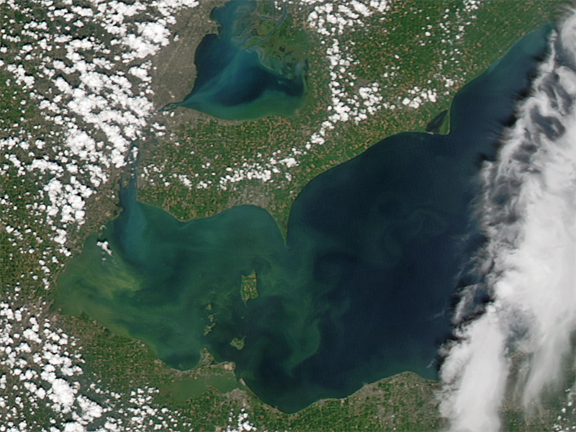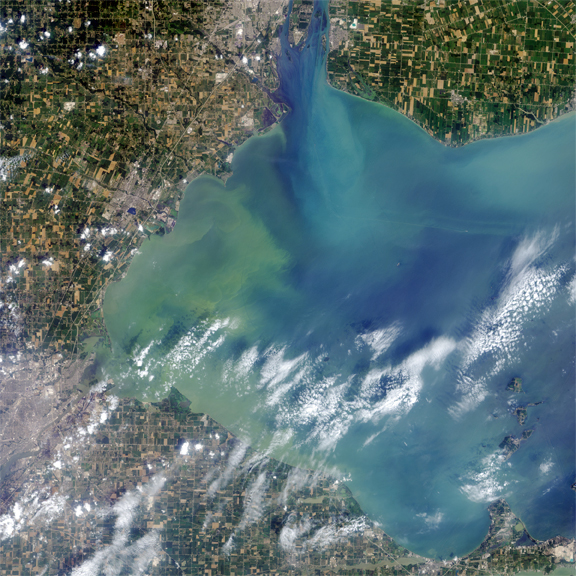

[SatNews] It was the 2014 bloom’s proximity to Toledo’s water intake that posed a problem this year, not the quantity or intensity...

On 8/3/2014 at 2:50 p.m. (EST), image captured by Moderate Resolution Imaging Spectroradiometer (MODIS) on NASA’s Aqua satellite, a view of an algae bloom in the west end of Lake Erie.
Photo courtesy of NASA.
The two photographs, captured by the Moderate Resolution Imaging Spectroradiometer on NASA’s Aqua satellite and the Operational Land Imager on Landsat 8, show milky green plumes of algae in Lake Erie on August 3 and August 1, respectively. The same bloom pictured was responsible for a three-day ban on drinking tap water in the Lake Erie coastal area. According to the Environmental Protection Agency (EPA), scientists have observed an acceleration in Lake Erie’s depletion of oxygen in the water (eutrophication) since the 1960’s; this accelerated, natural aging process is most notably evidenced by the abundance of algae blooms and is the result of elevated nutrient loadings from human activities.

On 8/1/2014 this image was captured by the Operational Land Imager (OLI) on the Landsat 8 satellite, a closer view of an algae bloom in the west end of Lake Erie. The OLI image includes a special “coastal blue” wavelength band that allows scientists to adjust for visual distortions caused by the atmosphere near the coast.
Photo courtesy of NASA/NOAA.
The EPA compiled a history of the algae’s activity throughout the last five decades. The timeline details the introduction of Zebra Mussels to Lake Erie in the 1980s, a species that would temporarily improve water clarity, but then backfire in the 1990s— “Using special video equipment, GLERL (Great Lakes Environmental Research Labs of The National Oceanic and Atmospheric Administration) showed that [zebra] mussels filter the water whether or not Microcystis is present, but they spit Microcystis back into the water, while at the same time they eat other algae. Thus, the competitors of Microcystis are removed." The blooms have continued to thrive each year throughout the last decade. (Microcystis is a genus of unicellular blue-green algae (family Chroococcaceae) forming irregularly shaped colonies within a common gelatinous envelope and including at least one species (M. aeruginosa) that is poisonous and may become abundant and troublesome in lakes especially where much organic matter is present.)
According to NASA’s Earth Observatory, The World Health Organization (WHO) determined that the water source for the city of Toledo, Ohio and the surrounding area had surpassed safe levels of Microcystis (1.0 parts per billion). On August 2, Toledo and Lucas County residents were warned not to consume water in a statement on the local government's official website:
“Chemists testing water at Toledo’s Collins Park Water Treatment Plant had two sample readings for Microcystis in excess of the recommended ‘DO NOT DRINK’ 1 microgram per liter standard. This notice applies to ALL customers of Toledo water. Most importantly, water should not be consumed until an all clear is issued. It is important to state that this drinking water alert does NOT recommend boiling, and in fact, boiling water can worsen the situation. Water should not be given to pets.”
The Ohio National Guard produced at least 33,000 gallons of waters, which was made available to residents at several distribution sites throughout the area. The drinking ban was lifted Monday, August 4 by Toledo Mayor D. Michael Collins, with official statement on the city’s website reading:
“Effective immediately, customers of the City of Toledo Public Water system may now safely drink tap water. Consistent test results have shown Microcystis no longer exceeds the recommended drinking water warning of 1 microgram per liter standard set by the World Health Organization in testing done by the City of Toledo, the Ohio EPA and the USEPA.”
The National Oceanic and Atmospheric Administration’s (NOAA) Harmful Algae Specialist Tim Davis at GLERL clarified that the 2014 algae bloom is not particularly intense, rather, north winds pushed the bloom towards the area’s water intake in Maumee Bay, resulting in an increase in Microcystis in the water supply. Concerns remain, though.
"Water plant operators along western Lake Erie have long been worried about this very scenario as a growing number of algae blooms have turned the water into a pea soup color in recent summers, leaving behind toxins that can sicken people and kill pets,” reported the Associated Press.
NOAA’s GLERL has since developed an Experimental Harmful Algal Bloom (HAB) Bulletin (under the “HABs” tab) in order to provide weekly updates for Microcystis blooms in western Lake Erie and issue warnings when harmful blooms are detected. The bulletin will show current location and projected future movement. The EPA management steps moving forward are also detailed:
“Canadian and United States Governments have supported a "hold the line on phosphorus levels" position to help prevent further deterioration of Lake Erie. In addition, much more effort must be expended on preventing exotic species, such as zebra and quagga mussels, from entering the Great Lakes.
Currently, there is much uncertainty as a result of insufficient knowledge of how the Lake Erie ecosystem is functioning and the factors and processes driving the ecosystem. The major, poorly understood changes in Lake Erie have taught us that management programs, research, and monitoring must be sustained and closely coupled in order to achieve our goals for Lake Erie. In addition, some managers have recommended that we explore development of management strategies to adapt to these invaders like zebra mussels, which are now a permanent part of the Great Lakes ecosystem.”
Further reading material:
NASA’s Earth Observatory: http://earthobservatory.nasa.gov/IOTD/view.php?id=84125&src=eorss-iotd
National Oceanic Atmospheric Administration’s Great Lakes Environmental Research Laboratory: http://www.glerl.noaa.gov/res/waterQuality/ (Experimental Bulletin Under HABs Tab)
Environmental Protection Agency: http://www.epa.gov/med/grosseile_site/indicators/algae-blooms.html

